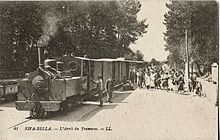Weidknecht

The Ateliers de Construction du Pont de Flandre, Weidknecht Frères & Cie built and sold steam locomotives between 1880 and 1929 . The administration building and factory were in the 19th arrondissement of Paris (1 Boulevard Macdonald in the Pont-de-Flandre quarter ).
history
The company was founded in 1876 by the Parisian engineer Frédéric Weidknecht (1842–1902), who received forty patents between 1872 and 1910 . These included a steam-powered omnibus that was presented in Paris in 1896.
Initially the company was called Bureau et Ateliers F. Weidknecht , until 1913 it was simply Weidknecht et Compagnie . In the early days, Weidknecht imported machines from abroad, but manufactured cranes and tools for railways himself. From 1879 on, he turned to the construction and sale of locomotives for small railways . The first to leave the factory in 1880 with the serial number 104 was a two- coupled tank locomotive (020T) for a gauge of 600 mm.
After his death, the company was taken over by his sons, the twins Adrien (1876–1906) and Amédée (1876–1928). By 1914 it had built around 300 locomotives, and 500 more were bought from abroad. Among the first were commissioned work for the Decauville company , which provided the machines built at Weidknecht with its own company signs.
After 1914, practically no activities in the railway sector can be identified. After Amédée Weidknecht's death, the factory was sold to the Société Cléro.
The Weidknecht system
On May 30, 1892, Frédéric Weidknecht registered a patent (No. 222000) for a radial locomotive axle, the Weidknecht system. The first application of this system was in the C1 'n2t locomotives of the Chemins de Fer Départementaux de la Drôme.
Production and sales
The production consisted mainly of narrow-gauge locomotives.
- Locomotives for
- Chemins de fer départementaux de la Drôme
- Compagnie des tramways de Loir-et-Cher
- Compagnie des chemins de fer à voie étroite et tramways à vapeur du Tarn
- Compagnie des tramways de l'Artois (TA) for the Tramway de Béthune à Estaires
- Chemin de Fer d'Aigues-Vives
- Tramway de Royan
- Chemins de fer du Calvados (CFC)
- Tramway de Gérardmer
- Compagnie du chemin de fer de l'Est-Marseille
- Chemins de fer de Thessalie
- Probably: the Artikutza railway
- Steam omnibuses
The plant also produced Loizeau stone crushers from 1886. This activity continued 130 years later under the Cléro brand.
As a locomotive dealer, Weidknecht also sold locomotives from the Heilbronn mechanical engineering company in Paris all over the world. A locomotive that was driven out in this way could still be found in ore mining in New Caledonia in 1965 .
Individual evidence
- ↑ World Exhibition Paris 1889.
- ^ Nouveau dictionnaire de biography alsacienne.
- ↑ a b c Michel Harouy: Un petit train de la Manche at Google Books, p. 146 ff.
- ↑ The Families of Michael Weydchecht, Hilsbach, Palatinate.
- ↑ Description of the machines et procédés pour lesquels des brevets d'invention ont été pris sous le régime de la loi du 5 juillet 1844.
- ↑ Portfolio économique des machines, de l'outillage et du matériel.
- ↑ Chemin de Fer Touristique du Tarn.
- ↑ Portefeuille économique des machines, de l'outillage et du matériel: Locomotive articulee a adherence totale par pendule compensateur.
- ↑ Portefeuille économique des machines, de l'outillage et du matériel: Omnibus automobile a vapeur.
- ^ Nouvelles annales de la construction. Volume 32.
